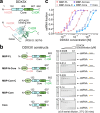Regulatory role of the N-terminal intrinsically disordered region of the DEAD-box RNA helicase DDX3X in selective RNA recognition
- PMID: 40877262
- PMCID: PMC12394722
- DOI: 10.1038/s41467-025-62806-7
Regulatory role of the N-terminal intrinsically disordered region of the DEAD-box RNA helicase DDX3X in selective RNA recognition
Abstract
DDX3X, a member of the DEAD-box RNA helicase family, plays a central role in the translational regulation of gene expression through its unwinding activity toward complex RNA structures in messenger RNAs (mRNAs). Although DDX3X is known to selectively stimulate the translation of a subset of genes, a specific sequence motif has not been identified; thus, the molecular mechanism underlying this selectivity remains elusive. Using solution nuclear magnetic resonance (NMR) spectroscopy, we demonstrate that the N-terminal intrinsically disordered region (IDR) of DDX3X plays a critical role in the binding and unwinding of structured RNAs. We propose that the selectivity toward target transcripts is mediated by its preferential binding to structured motifs, particularly the G-quadruplex structure, through arginine-rich segments within the N-terminal IDR. Our results provide a molecular basis for understanding translational regulation by DDX3X and highlight the remarkable role of the flexible IDR in controlling the cellular translational landscape.
© 2025. The Author(s).
Conflict of interest statement
Competing interests: The authors declare no competing interests.
Figures






References
-
- Rocak, S. & Linder, P. DEAD-box proteins: the driving forces behind RNA metabolism. Nat. Rev. Mol. Cell Biol.5, 232–241 (2004). - PubMed
-
- Linder, P. & Jankowsky, E. From unwinding to clamping - the DEAD box RNA helicase family. Nat. Rev. Mol. Cell Biol.12, 505–516 (2011). - PubMed
-
- Bourgeois, C. F., Mortreux, F. & Auboeuf, D. The multiple functions of RNA helicases as drivers and regulators of gene expression. Nat. Rev. Mol. Cell Biol.17, 426–438 (2016). - PubMed
-
- Bohnsack, K. E., Yi, S., Venus, S., Jankowsky, E. & Bohnsack, M. T. Cellular functions of eukaryotic RNA helicases and their links to human diseases. Nat. Rev. Mol. Cell Biol.24, 749–769 (2023). - PubMed
MeSH terms
Substances
Grants and funding
LinkOut - more resources
Full Text Sources

